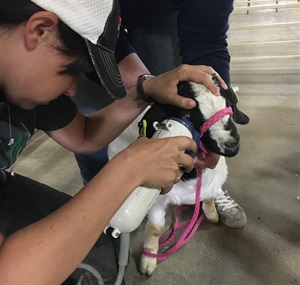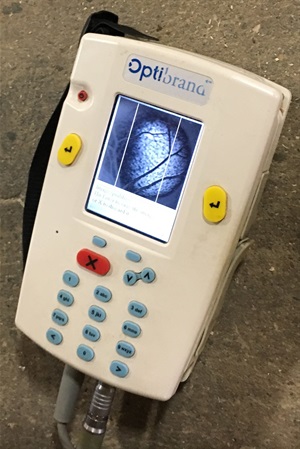Retinal Imaging Verifies ID of Showmanship Livestock
By Shaley Dehner, Weld County Communications Specialist, photos by Shaley Dehner
Retinal imaging has been around for quite some time in various areas such as ophthalmology for humans. However, the Weld County Fair uses retinal imaging to verify identification of livestock.
 Before retinal imaging came to the Weld County Fair around 2008, other technologies were used to verify livestock identification. Keith Maxey, CSU Extension Director, explained that ear tags have long been a trademark identifier within the fair business, but they came with some challenges.
Before retinal imaging came to the Weld County Fair around 2008, other technologies were used to verify livestock identification. Keith Maxey, CSU Extension Director, explained that ear tags have long been a trademark identifier within the fair business, but they came with some challenges.
“Any animal that came through that needed to be identified for the county fair, we would put an ear tag in them, and then we would do a nose print. And the reason to do both is because the ear tag was considered a non-permanent identification. It was easy and quick to see, but there were instances where ear tags were lost due to getting caught on something or they fell out,” he said.
Due to the lack of permanency an ear tag provided, it was eventually decided that two forms of identification should be required — a potentially non-permanent ear tag and a permanent method — for all county fair livestock. At first, market sheep and beef cattle received nose scans while goats had their ears tattooed. However, nose prints provided some struggles of their own, as capturing one was not the easiest to acquire.
“You literally took a pad of ink, placed it on the animal’s nose and had to quickly take the paper to it to get the ink to transfer on. Occasionally, you’d have them lick their nose in that split second so you’d have to start all over again or they’d shake their heads and the print would come out smudged,” explained Kimberly Sterkel, Weld County 4-H Youth Development Agent who currently helps ID each species.
There were also very few people around at that time who had the skill to verify nose prints as they were like reading a fingerprint. As for goat tattoos, they were a superior form of permanent identification and were easy to verify, but they faded over time, as most tattoos do.
For pigs, ear notching is the safest and smartest form of identification. Maxey explained that due to a pig’s knack for squirming and squealing, the ability to hold their head still for a nose scan or ear tattoo, is nearly impossible. Therefore, notching each pig’s ear came to be that animal’s permanent form of identification.
Retinal imaging has advantages that other identifying technology such as DNA testing does not. Although DNA testing as a form of livestock identification has been used for decades in other fairs, the Weld County Fair has always preferred to use retinal imaging because it is more affordable and timely.
With DNA testing, it can take weeks to get results back; no instant identification can be gleaned. Instead, with retinal imaging, a trained technician can take a scan of an animal’s retina once, then again at another time, and will be able to tell if it’s the same animal or not.
Some fairs across the country — including a few in Colorado — have had problems with cheating. But that’s not why the Weld County Fair uses retinal imaging to identify livestock.
“Retinal imaging was simply a new technology,” Maxey said. “It merely replaced an older technology that was used to verify identification. And one of the applications could be to prevent cheating.”
But in Maxey’s 22 years with the Weld County Fair, he can’t recall any proven cases of cheating. “People expressed suspicions, but they were just that, suspicions,” he said. “But retinal imaging gives us a way to rectify that very quickly and easily. This way, we make sure that everything is above board and put to rest any suspicions.”
 The process of retinal imaging is quite simple. Maxey explained how they use a machine called an OptiReader Device to scan the livestock’s eye. First the technician must program a flashcard and put a GPS lock on the device to record the date and location that the photos were taken. The livestock are restrained so the technicians can take the best possible scan. Beef cattle are put in livestock chutes with their head held in place while goats and sheep are generally restrained by hand.
The process of retinal imaging is quite simple. Maxey explained how they use a machine called an OptiReader Device to scan the livestock’s eye. First the technician must program a flashcard and put a GPS lock on the device to record the date and location that the photos were taken. The livestock are restrained so the technicians can take the best possible scan. Beef cattle are put in livestock chutes with their head held in place while goats and sheep are generally restrained by hand.
The OptiReader Device is basically a glorified flashlight; it’s a light that shines into the animals’ eye but isn’t bright enough to harm the animal. The light shines through the pupil to the back of the eye where the blood veins are at — the animal’s retina. This will show a pattern of veins. The machine automatically knows the pattern it’s looking for related to each animal.
 “For cattle, it’s described as a tree. You have a main trunk then several branches that go off to the sides. For sheep and goats, it’s more of a bush-like appearance. To have consistency, you want the image to be as vertical as possible,” Maxey said. A photo of the animal’s ear tag is also taken to have as part of its record. Individual record pages are then printed off to show the animal’s retinal images and ear tag data.
“For cattle, it’s described as a tree. You have a main trunk then several branches that go off to the sides. For sheep and goats, it’s more of a bush-like appearance. To have consistency, you want the image to be as vertical as possible,” Maxey said. A photo of the animal’s ear tag is also taken to have as part of its record. Individual record pages are then printed off to show the animal’s retinal images and ear tag data.
Maxey went on to say that only one eye needs to be scanned, but they usually scan both eyes. This is due to one eye potentially having a disease or being injured. Another interesting tidbit is that an animals’ retinal images stay the same from the time they are born to the time they die and each eye’s pattern differs from the other.
“They truly are unique,” he said.